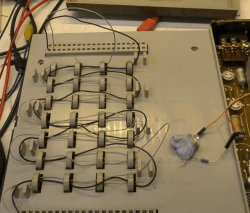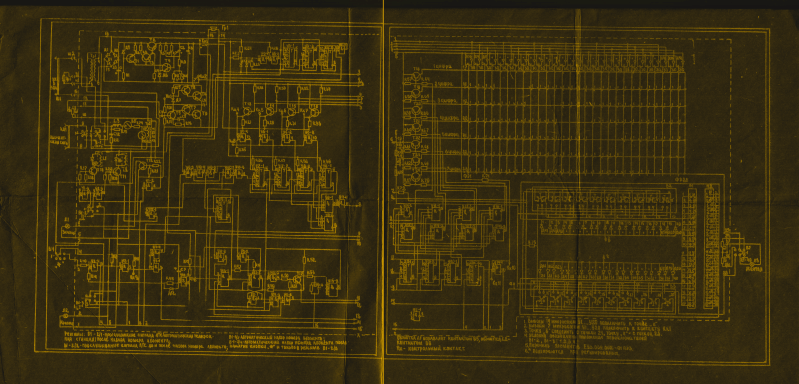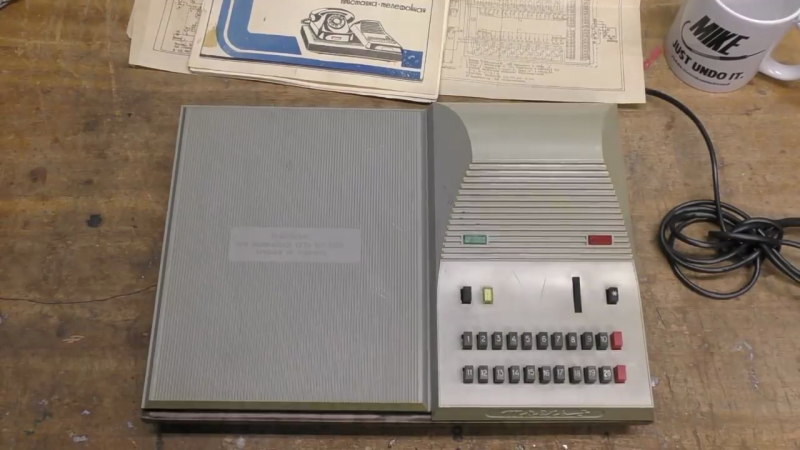If you thought programming your 1990s VCR was rough, wait until you see this Russian telephone autodialer that [Mike] took apart over on the mikeselectricalstuff YouTube channel (video below the break). [Mike] got this 1980s Soviet-era machine a few years ago, and finally got around to breaking into it to learning what makes it tick. The autodialer plugs into the phone line, much like an old-school answering machine. It provides the user with 40 pre-set telephone numbers, arranged in two banks of 20, and a speaker to monitor the connection process. It uses pulse dialing — no touch tones. What’s surprising is how you program the numbers. Given that this was build in the 1980s Soviet Union, he wasn’t expecting a microcontroller. But he wasn’t expecting transformer core “rope” memory, either.

The phone normally sits on a platform on the left side of the machine. Raising up the platform exposes a bank of toroidal cores, arranged in seven rows of four. Each row corresponds to a dialed digit, and the four cores used to encode a single digit. At the top and bottom of the programming board are two 40-pin connectors, each pin corresponding to one of the preset phone numbers. A bunch of patch wires would have been provided, and you program each number by threading a long wire through the appropriate cores, connecting it at the top and bottom connectors much like a modern solderless breadboard. It’s also interesting to see the components and construction technique of this circuit board. For example, the diodes have the strip on the Anode end, not the cathode as we’re normally used to today. The transistor cans are mounted upside down like dead spiders.

Mike tries to decipher the schematics and pokes around enough to get the gist of how it works. This design is an interesting solution to the problem of building an autodialer in that era. If you want to learn more about core memory, here’s an article we wrote about deciphering an Apollo rope memory module, perhaps one of the most well-known examples of this technology. We also covered a couple of projects using rope memory techniques but on a small scale, here and here.
















Wow, that’s ingenious. I love seeing soviet technology.
I second that! I kind of do admire ex-soviet technology. In its own way, it was reasonable and modest. Yet, it wasn’t without elegance.
Same goes for their space travel. Satellites (poor animals! 😢), space capsules, orbital stations..
Okay, MIR was buggy and caused headaches no end. But to the layman, the atmosphere up there was more human and modest. Not as stylish, professional as the ISS. There, everything is strictly regulated through schedule.
The naming schemes were also interesting.
Devices were labeled differently than in the western world. “Instrument so-and-so Model No. 5” vs “Super Pro XXL Ultra”. ;)
Their starships had actual names, though. Kristall, Spektr etc.
However, there’s a catch, too. Soviet era power supplies were horrible: You could recognize Soviet radio amateurs in morse telegraphy solely by ear (squeak squeak squeeeek or whee-whee-wheeee instead of di-di-daaah).
I guess because they had a capacitor shortage or something along these lines. The Junost b/w TVs were horrible inside, for example. Their power supplies were huge, ugly and unstable. The wiring was horrendous, too.
Cables everywhere. No managment, at all. To fix something, all these cables that to be disconnected. By comparison, western or Japanese TV technology was far ahead. The modular designs of their TVs made service/repair jobs much, much easier. The Soviet’s CRT tubes themselves, however, were not bad I think.
Computers and scientific equipment, though, by contrast, were often using a lot of high quality golden parts and manual wiring. They were thus very durable, I suppose. Corrosion etc. didn’t damage them.
As someone who did use soviet-era electronics, I mostly agree with you. Older b/w TVs were of terrible quality and often developed bad solder joints. A temporary fix was for these to literally whack the TV with your fist if something doesn’t work :)
Newer ones (built right before the breakup) were somewhat better-built. I remember disassembling an old compact color TV (80s to early 90s) and it had modular card-based construction.
Smart people working under a stultifying system, they really came up with some fantastic results.
Years ago, when I worked at one of the “Big Three”, I sat in as part of an interview committee for a recent Russian immigrant who was applying for a production engineering position.
HR asked him if he had any experience with PLCs. In his broken English he said “No,” and as far as the HR was concerned, the interview was over.
However, I got to talking with the guy and discovered that while he had no experience with *off the shelf* PLCs (you really couldn’t get one over there) he had in fact BUILT SEVERAL OF HIS OWN for his last employer….”Building his own” as in—wiring up a Soviet processor, RAM and glue chips designing including I/O circuitry including isolated inputs and relay drivers, then writing his own assembler so that he could then write his own PLC code.
The guy wasn’t just an appliance user, he actually knew how to build something from nuts, gates, and bits. If it had been my show, I would have offered him a job right then and there. In fact, I argued heavily on his behalf.
In their infinite wisdom, the HR drone ruled against me, because “the requisition required PLC Experience and the applicant stated that he didn’t have that experience.” I sometimes wonder what became of him. Maybe a millionaire tech giant.
So, yeah, there were a LOT of really smart people over there.
Oh my God, that’s amazing! Shame he didn’t get the job, such a waste of talent, hope he did well.
Yes, except the rope core memory was invented in the US and the Soviets copied the tech.
Isn’t everyone other than the inventor “copying” a technology unless they happen to reinvent the wheel without knowing it? For the purpose of this discussion, what does it matter in which country the technology was first invented?
And even if this was about IP rights, US companies constantly steal from others under a corrupt oligopolistic system of mutually assured destruction that only ensures small companies and individuals cannot compete against large ones. Fairness went out the window long ago.
It was related to the comment making claims of smart people, when it’s quite likely the implementation was copied as well. Probably some telephone exchange board contained this exact feature to speed-dial fixed routes through the system.
The Soviet system really didn’t reward independent creative thinking. Stalin saw engineers as a threat because anyone who became specialized enough would become indispensable, and therefore politically dangerous. That’s why he held those show trials and executed all the engineers who helped industrialize the nation. That’s why everyone just copied stuff as much as possible and avoided doing anything inventive.
Indeed. It’s always good to see this sort of thing.
Sometimes the approachs can provide some inspiration elsewhere. I have always liked the ingenuity that comes with squeezing lots of functionality out of a simplistic design.
That video reminded me of a surplus keyboard that worked on a similar principle. Each key operated a microswitch that connected to a wire threaded through a selection of cores to generate the character. Unfortunately I broke it down for the components before thinking to work out which character set it used. The chassis was heavy diecast.
>The transistor cans are mounted upside down like dead spiders.
>
Does this help with cooling? I remember air has poor thermal conductivity. It’s just a thought I had. The PCB, if touched, would conduct heat away faster. But since there are no visible silicone pads or grease I’m likely deluding myself. I’d love to read a thought about it though.
cooling yes, but during soldering. Germanium transistors have the leads soldered onto the semiconductor, no bond wires.
We acquired something similar on a card for our PDP8 that meant we no longer had to enter the disc boot code manually on the front panel switches… only a few words, but a few words was all you needed (though the cores were considerably smaller than this example, and required a magnifying glass and a pair of tweezers to program),
Owlman — I know what you’re talking about. At my first coop job back in 1981, I was assigned this ancient Data General Nova 2 “mini computer” to get up and running again. I found in the manual how to start it up. There was a non-trivial number of op codes you’d have to program into the machine via the front panel switches to get it to boot into the operating system. One day one of the engineers who had worked on the machine told me the secret. Like your PDP8, this computer was equipped with an “auto boot” PROM. I don’t think it was core, however. To boot, you only toggled one one code, which varied only depending on which device you wanted to boot from (disk, tape, paper tape). The PROM accessory did the rest.
This computer has another feature called power restore. Upon detecting power failure, it saved a handful of CPU registers in core memory before the power supply capacitors had time to fully drain. On power up, it picked up from where it was interrupted without missing a beat. When I read about this I couldn’t believe it, so I had to test it. I started compiling a file, and before it could finish I pulled the plug out of the wall. I went to lunch. After lunch, I plugged it back in, and it completed the compilation with no issues.
A few years ago when CuriousMarc was restoring the old Apollo guidance computer, I became confused about the principles of rope core memory and core memory. I finally cleared it up in my mind by realizing that despite being similar, they store data using completely different techniques. Core memory stores data in the magnetic fields of each core. Rope memory stores data in the wiring pattern. You could take a giant magnetic field and randomly flip around or remove the flux from the cores in a rope memory, and then subsequently power it up and read the intended data as if nothing happened. That won’t work with core memory.
What had confused me in the past is just how similar these technologies are. The use essentially the same kinds of cores. They both rely on the physical properties of a toroidal transformer, albeit in different ways. They both have insanely intricate wiring. Circuits to drive the arrays are very similar.
I thought I’d share this in case it helps anyone else.
when I was a teenager I garbage picked some of the coolest places. One was a Burroughs computer repair center where they often tossed out reel2reel mainframe type units. Everything in these units was modular. I pulled a memory card from one, took it home, and took it apart. It had the coolest rope memory i had ever seen. The toroids were about a 1/16″ or 1.5mm. I took it to the local college and had a friend take some pictures of it with an electron microscope. Way cool. One of the places i picked was going out of business and threw out a Radio Schack pocket autodialer. I used it at a payphone and after my call a business man walked up and asked what it was. I responded that it was an autodialer and the man went to the Radio Shack across the street and bought one. He then asked for my help programing it. The dialer held twenty numbers. He didn’t understand why a 13 year old kid had a 70 USD dialer. He refused to believe I garbage picked it. It did not use rope memory. this was 1983 or 84.
Touch Tone is an AT&T trade mark. It should actually be called DTMF for Dual Tone Multi Frequency. Happy new year.
Kudos to [Mike] for his coffee mug!
(in the Title Photo)
Was in the Ukraine a couple years back, picked up a dead board out of an adding machine for about $0.50. That has lead down to alot if hours learning about Nixie Tubes, Amazing what was done in the past, given history repeats, a shame so much of that tech gets lost.
For diode markings- that was not the only one oddity. Russian parts or schematics where infamous of more of that. I have old book from 50’s with parts catalogue that is full of that markings : “CCCP – mind reverse polarity!” Few types of transistors got same pitfalls… I believe they did that only to stand out or prove superiority of Soviet technology by forcing reverse standards.
Magnetic core store readers were used in the 70’s and early 80’s to store mission data stored in fighter aircraft. At the end of a mission or sortie the support crew downloaded data from the aircraft into the core store reader. The terminology stuck, and even with the advent of solid state memory, the downloading device was still referred to the core store reader.
If you want to check out the machine in working order you should check out this video:
https://www.youtube.com/watch?v=PWOxAn3i-f8